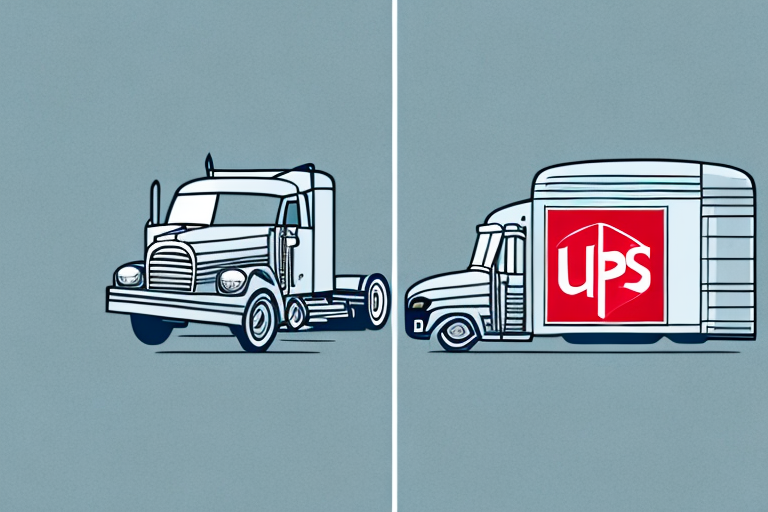Comparing Shipping Rates: USPS vs UPS
When it comes to shipping packages, there are numerous options available today. However, two of the most popular choices are the United States Postal Service (USPS) and United Parcel Service (UPS). Both offer a variety of domestic and international shipping services, but which one is the better choice for your needs? In this article, we'll take a detailed look at the shipping rates, services, and options offered by USPS and UPS so you can make an informed decision.
Introduction to USPS and UPS
The USPS, also known as the Postal Service or U.S. Mail, is a government agency responsible for providing postal services in the United States. Founded in 1775, the USPS employs over 600,000 people and operates more than 31,000 post offices nationwide. In contrast, UPS is a private package delivery company founded in 1907. UPS operates in over 220 countries and territories worldwide, with a fleet exceeding 500,000 vehicles and airplanes. In terms of size and reach, UPS is the larger of the two shipping carriers we are comparing here.
While both USPS and UPS offer package delivery services, there are key differences between them. One of the main distinctions is their pricing structure. USPS tends to be more affordable for smaller packages and shipping to rural areas, whereas UPS often proves more cost-effective for larger packages and international shipments.
Another major difference lies in the level of tracking and delivery confirmation offered. USPS provides basic tracking information for most packages, while UPS offers more advanced tracking options, including real-time updates and delivery confirmation signatures.
Shipping Services Offered by USPS and UPS
Both USPS and UPS provide a range of shipping services to customers. The USPS offers various options for shipping letters, documents, and packages, such as First-Class Mail, Priority Mail, and Priority Mail Express. UPS offers similar services, including UPS Ground, UPS 2nd Day Air, and UPS Next Day Air. Additionally, UPS provides specialized services like Freight, Supply Chain Solutions, and Logistics, which are not available through USPS. This can be a crucial factor if your business requires specialized shipping needs.
Both carriers offer tracking services for packages, but the level of detail varies. USPS offers basic tracking information, such as shipment and delivery status, while UPS provides more detailed tracking, including the package's current location and estimated delivery time. This level of detail can be important if you need to closely monitor the delivery of your packages.
Domestic Shipping Rates for USPS and UPS
Cost is a pivotal factor when choosing a shipping carrier. Both USPS and UPS offer rate calculators on their websites to help customers estimate shipping costs based on package size, weight, and destination. Generally, USPS is cheaper for lighter packages and shipping to residential addresses. On the other hand, UPS might be more expensive for lighter packages but offers better rates for heavier and larger shipments. Both carriers also provide various discounts and promotions throughout the year, so it's beneficial to check their websites for potential savings.
Delivery time is another critical factor. USPS offers options like Priority Mail, which typically takes 1-3 business days, and First-Class Mail, which can take 1-3 business days for local shipments and up to 3-5 business days for national deliveries. UPS, meanwhile, offers services such as Ground, generally taking 1-5 business days depending on the destination, and Next Day Air, which guarantees delivery by the next business day. Consider your shipping needs and timelines when choosing between USPS and UPS.
International Shipping Rates for USPS and UPS
For international shipments, both USPS and UPS offer a variety of services. USPS provides International First-Class Mail, Priority Mail International, and Express Mail International. UPS offers services like UPS Worldwide Express, UPS Worldwide Expedited, and UPS Worldwide Saver. Typically, UPS is more expensive for international shipments but may offer faster delivery times and more reliable tracking options. Both carriers have rate calculators on their websites, allowing you to compare prices and choose the best option for your needs.
International shipping rates can vary significantly based on the destination country, package weight and dimensions, and the type of service selected. Additionally, some countries have restrictions on certain items, so it's crucial to check with the carrier and review the destination country's customs regulations before shipping.
Both USPS and UPS offer additional services for international shipments, such as customs clearance assistance and insurance options. These services provide added security and protection for your package during transit but may come with additional fees. Weigh the costs against the benefits to determine what's best for your specific shipment.
Understanding the Differences in USPS and UPS Package Delivery Options
Delivery options are another important consideration when choosing a shipping carrier. USPS offers standard delivery times, along with services like Certified Mail and Registered Mail for enhanced security and tracking. UPS provides standard delivery times and additional options like same-day and next-day delivery for faster service.
USPS offers a wide range of package sizes, including flat-rate boxes and envelopes, which can be a cost-effective option for smaller items. UPS has weight and size restrictions on packages, which may limit your shipping options for larger or heavier items.
In terms of international shipping, USPS offers services such as First-Class Mail International and Priority Mail International, while UPS provides a broader range of international shipping services, including air and ocean freight, customs brokerage, and comprehensive international package and document services. If you frequently ship internationally, consider which carrier offers the best options for your needs.
Tracking Packages with USPS and UPS
Both USPS and UPS allow customers to track packages online using a tracking number provided at the time of shipment. UPS generally offers more detailed tracking information, including estimated delivery dates, signature confirmation, and real-time package location updates. USPS provides tracking information such as package status and delivery confirmation but may not offer as much detail as UPS. If precise tracking is important to you or your business, UPS's advanced tracking options may be more suitable.
Insurance Options for Shipping with USPS and UPS
Protection against loss or damage during shipment is available through insurance options offered by both USPS and UPS. USPS includes $50 of insurance with Priority Mail and up to $5,000 with Priority Mail Express, with additional coverage available for purchase. UPS includes $100 of insurance with most shipments and offers additional coverage options up to $100,000 for purchase. If you're shipping valuable or fragile items, comparing the insurance options and ensuring adequate protection is essential.
Comparing Delivery Times: USPS vs UPS
Delivery times can vary based on the shipping carrier and the service option selected. Generally, USPS has longer delivery times compared to UPS. USPS Priority Mail typically takes 1-3 business days for domestic delivery, whereas UPS Ground usually takes 1-5 business days. UPS also offers faster delivery options like Next Day Air and Second Day Air. If fast delivery is a priority, UPS may be the better choice.
Customer Service Comparison: USPS vs UPS
Both USPS and UPS provide customer service through phone and email support, including options to file claims for lost or damaged packages. However, UPS generally receives higher customer service ratings compared to USPS. UPS also offers a more advanced tracking system and dedicated customer service teams for large businesses. If customer service is a crucial factor for you or your business, UPS might be the preferable option.
Environmental Impact of Shipping with USPS and UPS
Environmental sustainability is increasingly important to consumers, making the eco-friendliness of shipping carriers a significant consideration. Both USPS and UPS have sustainability initiatives in place. UPS has a carbon-neutral shipping program and aims to use 25% alternative fuel by 2020, with ongoing efforts to reduce its environmental footprint. The USPS has implemented various energy-saving measures in its facilities and maintains a robust recycling program. If environmental responsibility is important to you, comparing the sustainability efforts of both carriers can guide your decision.
Additional Fees to Consider When Shipping with USPS vs UPS
Beyond shipping rates, it's important to account for any additional fees that may apply when using USPS or UPS. Both carriers charge extra for signature-required deliveries, special handling, and oversized packaging. UPS also imposes fees for residential deliveries and address corrections. Before selecting a shipping carrier, ensure you understand any additional fees that might apply to your specific shipment to avoid unexpected costs.
Choosing the Best Shipping Carrier for Your Business or Personal Needs
After evaluating all the factors discussed, you should be better equipped to decide whether USPS or UPS is the right choice for your shipping needs. Numerous variables come into play, but ultimately, it depends on your individual requirements and priorities. Whether you're a small business owner shipping products to customers or an individual sending a package to a friend or family member, researching and comparing your options can help you save money and ensure your shipment arrives safely and on time.
Tips to Save Money on Shipping Costs with USPS or UPS
Shipping costs can accumulate quickly, especially if you're sending multiple packages. However, there are several strategies to help reduce shipping expenses with both USPS and UPS. For instance, utilizing flat-rate boxes or envelopes can offer cost savings. Additionally, taking advantage of discounted shipping rates through certain online marketplaces can lower costs. Enrolling in loyalty programs or using a shipping software can also help you save money on shipping costs over time.
Conclusion: Making the Right Choice Between USPS and UPS
Selecting the appropriate shipping carrier for your needs may seem daunting initially, but by considering all the factors discussed in this article, you can make an informed decision. It's essential to evaluate the shipping rates, services, options, and additional fees offered by both carriers, as well as other important factors such as customer service and environmental sustainability. Whether you choose USPS or UPS, taking the time to research and compare your options can help you save money and ensure that your shipments arrive safely and punctually.






















